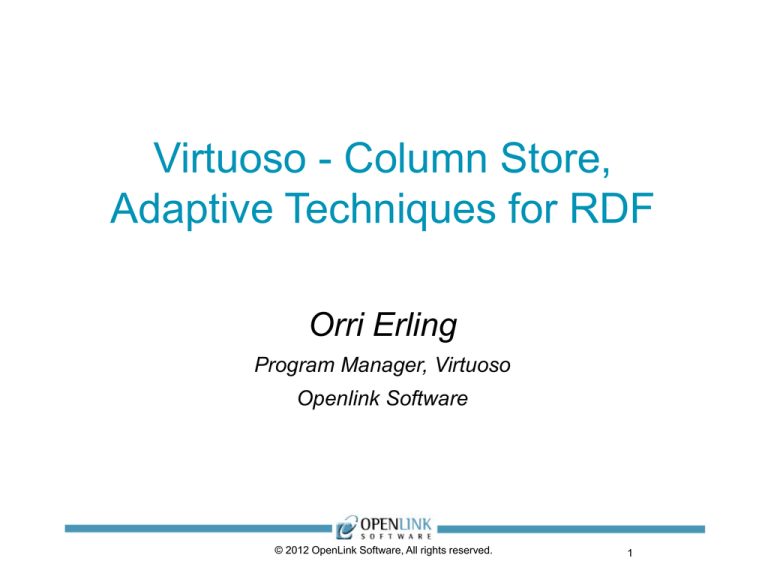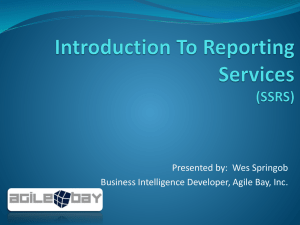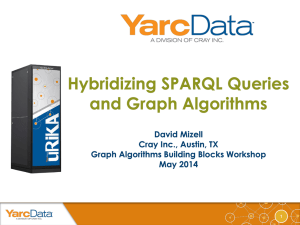
Virtuoso - Column Store,
Adaptive Techniques for RDF
Orri Erling
Program Manager, Virtuoso
Openlink Software
© 2012 OpenLink Software, All rights reserved.
1
Flexible Big Data
Data grows in volume and heterogeneity
Schema last is great - if the price is right
RDF, graphs promise powerful querying with
the flexibility and scale of no-SQL key value
stores
Inference may be good for integration, if can
express the right things, beyond OWL
RDF tech must learn the lessons of DB,
everything applies
© 2012 OpenLink Software, All rights reserved.
2
Virtuoso Column Store Edition
SQL and SPARQL
Compressed column store, vectored
execution
Shared nothing scale out
Powerful procedure language with parallel,
distributed control structures
Full-text and geospatial indexes
© 2012 OpenLink Software, All rights reserved.
3
Storage
Freely mix column-, and row-wise indices
All SQL and RDF data types natively supported , single
execution engine for SQL/SPARQL
Column compression 3x more space efficient than rowwise compression for RDF
Column stores are not only for big scans, random
access surpasses rows as as soon as there is some
locality
9 B/quad with DBpedia, 7 B/quad with BSBM or RDF-H,
14 B/quad with web crawls (PSOG, POSG, SP, OP, GS,
excluding literals)
© 2012 OpenLink Software, All rights reserved.
4
Execution Engine
Vectoring is not only for column stores
Vectoring makes a random access into a linear merge join if
there is any locality: Always a win, mileage depends on run
time factors
Vectoring eliminates interpretation overhead and makes
CPU friendly code possible
Even with run time data typing, vectoring allows use of typespecific operators on homogenous data, e.g. arithmetic
Dynamically adjust vector size: Larger vector may not fit in
cache but will get better locality for random access
© 2012 OpenLink Software, All rights reserved.
5
Graph operations
Run time computation plus caching instead of materialization
SPARQL/SQL extension for arbitrary transitive subqueries:
Flexible options for returning shortest paths, all paths, all
/distinct reachable, attributes of steps on paths etc.
Efficient execution, searching the graph from both ends if
looking for a path with ends given
Query operators for RDF hierarchy traversal
Special query operator for OWL sameAs and IFP based
identity
Taking OWL sameAs / IFP identity into account for DISTINCT
/GROUP BY
© 2012 OpenLink Software, All rights reserved.
6
Query Optimization Challenges
Typical SQL stats do not help
Need to measure data cardinalities starting from
constants in the query
Need to sample fanout predicate by predicate, as
needed
Predicate and class hierarchies are easy to handle
in sampling
sameAs or IFP inference voids all guesses
Is hash join worthwhile? High setup cost means
that one must be sure of cardinalities first
© 2012 OpenLink Software, All rights reserved.
7
Deep Sampling
Everything is a join -> sampling must also do joins
As the candidate plan grows, the cost model executes
all the ops on a sample of the data
Actual cardinality and locality are known, also when
search conditions are correlated
Having high confidence in the cost model, hash join
plans become safe and attractive
Even though there is an indexed access path for all, a
scan can be better because it produces results in
order. Need to be sure of selectivity before taking the
risk
© 2012 OpenLink Software, All rights reserved.
8
Elastic Cluster
Data is partitioned by key, different indices
may have different partition keys
Partitions may split and migrate between
servers
Partitions may be kept in duplicate for fault
tolerance/load balancing
Actual access stats drive partition split and
placement
© 2012 OpenLink Software, All rights reserved.
9
Optimizing for Cluster
Vectored execution is natural in a cluster since single-tuple messages
are not an option
Keep max ops in flight at all times, always send long messages
Fully distributed query coordination:
Any node can service a client request. Correlated subqueries,
stored procedures may execute anywhere, arbitrary parallelism and
recursion between partitions
On single shared memory box, cluster is approximately even with
single process multithreading, low overhead
Distributed stored procedures, send the proc to the data, as in mapreduce, except that there are no limits on cross partition
calling/recursion
Choice of transactional and auto-commit update semantics, can
have atomic ops without global transaction
© 2012 OpenLink Software, All rights reserved.
10
LOD Cache
55 billion triples in LOD cache, only 384 GB of
RAM, 2TB disk
Most of Linked Open Data and Web Crawls
http://lod.openlinksw.com
http://lod.openlinksw.com/sparql
© 2012 OpenLink Software, All rights reserved.
11
Future Work
Complete deep sampling: No more bad query
plans
Caching and recycling of intermediate results,
specially inference and partial plans
Automatic cluster sizing and load redistribution
Automatic balancing of storage between disk and
SSD
Run TPC-H and TPC-DS in SQL and their 1:1
translation in SPARQL, demonstrating SPARQL
performance as near to SQL as possible
© 2012 OpenLink Software, All rights reserved.
12
Making Technology Work For
You
openlinksw.com/virtuoso
© 2012 OpenLink Software, All rights reserved.









